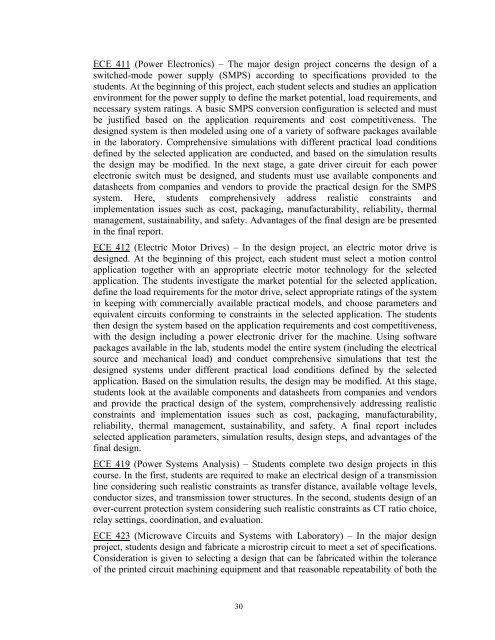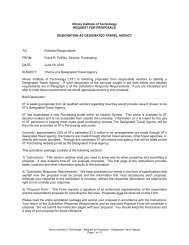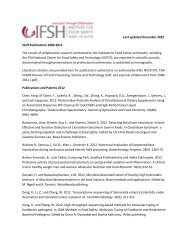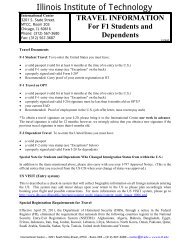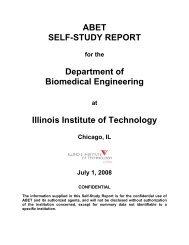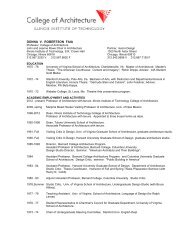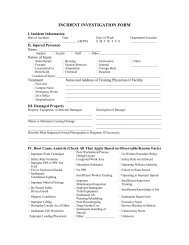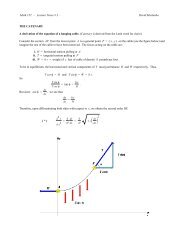IIT BSCPE Self Study 2008 - Illinois Institute of Technology
IIT BSCPE Self Study 2008 - Illinois Institute of Technology
IIT BSCPE Self Study 2008 - Illinois Institute of Technology
Create successful ePaper yourself
Turn your PDF publications into a flip-book with our unique Google optimized e-Paper software.
ECE 411 (Power Electronics) – The major design project concerns the design <strong>of</strong> a<br />
switched-mode power supply (SMPS) according to specifications provided to the<br />
students. At the beginning <strong>of</strong> this project, each student selects and studies an application<br />
environment for the power supply to define the market potential, load requirements, and<br />
necessary system ratings. A basic SMPS conversion configuration is selected and must<br />
be justified based on the application requirements and cost competitiveness. The<br />
designed system is then modeled using one <strong>of</strong> a variety <strong>of</strong> s<strong>of</strong>tware packages available<br />
in the laboratory. Comprehensive simulations with different practical load conditions<br />
defined by the selected application are conducted, and based on the simulation results<br />
the design may be modified. In the next stage, a gate driver circuit for each power<br />
electronic switch must be designed, and students must use available components and<br />
datasheets from companies and vendors to provide the practical design for the SMPS<br />
system. Here, students comprehensively address realistic constraints and<br />
implementation issues such as cost, packaging, manufacturability, reliability, thermal<br />
management, sustainability, and safety. Advantages <strong>of</strong> the final design are be presented<br />
in the final report.<br />
ECE 412 (Electric Motor Drives) – In the design project, an electric motor drive is<br />
designed. At the beginning <strong>of</strong> this project, each student must select a motion control<br />
application together with an appropriate electric motor technology for the selected<br />
application. The students investigate the market potential for the selected application,<br />
define the load requirements for the motor drive, select appropriate ratings <strong>of</strong> the system<br />
in keeping with commercially available practical models, and choose parameters and<br />
equivalent circuits conforming to constraints in the selected application. The students<br />
then design the system based on the application requirements and cost competitiveness,<br />
with the design including a power electronic driver for the machine. Using s<strong>of</strong>tware<br />
packages available in the lab, students model the entire system (including the electrical<br />
source and mechanical load) and conduct comprehensive simulations that test the<br />
designed systems under different practical load conditions defined by the selected<br />
application. Based on the simulation results, the design may be modified. At this stage,<br />
students look at the available components and datasheets from companies and vendors<br />
and provide the practical design <strong>of</strong> the system, comprehensively addressing realistic<br />
constraints and implementation issues such as cost, packaging, manufacturability,<br />
reliability, thermal management, sustainability, and safety. A final report includes<br />
selected application parameters, simulation results, design steps, and advantages <strong>of</strong> the<br />
final design.<br />
ECE 419 (Power Systems Analysis) – Students complete two design projects in this<br />
course. In the first, students are required to make an electrical design <strong>of</strong> a transmission<br />
line considering such realistic constraints as transfer distance, available voltage levels,<br />
conductor sizes, and transmission tower structures. In the second, students design <strong>of</strong> an<br />
over-current protection system considering such realistic constraints as CT ratio choice,<br />
relay settings, coordination, and evaluation.<br />
ECE 423 (Microwave Circuits and Systems with Laboratory) – In the major design<br />
project, students design and fabricate a microstrip circuit to meet a set <strong>of</strong> specifications.<br />
Consideration is given to selecting a design that can be fabricated within the tolerance<br />
<strong>of</strong> the printed circuit machining equipment and that reasonable repeatability <strong>of</strong> both the<br />
30


